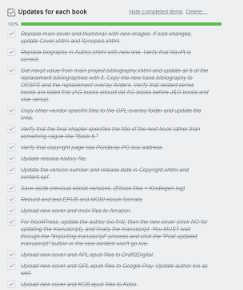I’m a big fan of procedures. I’m one of those people who creates a check list for nearly everything I have to do more than once. In a recent conversation with my wife, I said, “Anything worth repeating is worth proceduralizing.” It was a line I had to add to my collection of personal quotes (although I changed proceduralizing to systematizing because, technically, proceduralize isn’t a word).
Procedures take many forms. A check list is an obvious example that I’ll use throughout this article, but templates, instructions, and style guides serve a similar function. A procedure is anything that helps you document the proper way to complete a task.
I understand that not everyone cares for procedures as much as I do. Some people find them restrictive or boring, or they feel that procedures kill creativity. I get that. But I’d argue that those attitudes arise from the dark side of procedures, which I’ll get to later.
Procedure Benefits
Let’s look at the bright side first. Done well, systematizing a repeated process as a procedure delivers many benefits:
- Improved quality. A procedure reduces the opportunity for human errors such as forgetting a step or doing things out of order. Following a procedure that is designed to produce good results should consistently produce good results.
- Improved efficiency. You can complete most tasks in a variety of ways, but there’s usually one specific approach that’s the most efficient. If you create a procedure that reflects that most efficient approach, you will always maximize your performance.
- Documentation. If you are new to a process, a formalized procedure is gold. It allows you to advance through the process at your own pace without the judgment or impatience of an overseer. The rest of the staff can get on with their own work, assisting you only when necessary. Additionally, a completed check list can serve as evidence of exactly what was done should questions arise later.
- Mental energy conservation. Repeated tasks have a tendency to become boring after the umpteenth iteration. Procedures actually help with that because they allow you to speed through the repetitive elements. You can reserve your mental energy for any exceptions that occur rather than expending it on the basic requirements of the task.
- Quick recovery from interruptions. After someone interrupts your work, the question, “Where was I?” is much easier to answer if you were following a formal procedure. You always know which steps you’ve completed and which steps remain.
- Sense of completion. Nothing says “done” like having checked off all the boxes.
- Reduced stress. A communication coach named Dick Haab once told me, “Stress is created by the gap between where you are and where you want to be.” I would add that the more uncertainty associated with traversing the gap, the higher the stress. Every task you have to perform is essentially a gap between where you are and where you want to be. Having a proven procedure for completing the task reduces uncertainty and gives you valuable confidence in successfully achieving the desired outcome.
Adaptability Is Key
The polish that makes the above benefits gleam comes from a caveat to my earlier quote about systematizing, and that is: no procedure should be set in stone. A living procedure adapts to changes in business practices and the work environment. A procedure that doesn’t adapt becomes dead weight.
The first time I have to repeat a task, I start a check list for getting the job done. Initially, the check list simply records the steps I perform. On subsequent passes, I make notes on how the process can be improved and then tweak the check list accordingly when I’m done. I spend the bulk of my mental energy on process improvement rather than on the repetitive aspects of the work. Over time, the procedure improves, and it always reflects the current environment. Meanwhile, I get faster and better at completing the task.
Welcome to the Dark Side
Procedures do have a dark side, but the darkness usually comes about because of people problems rather than process problems. The reasons for why procedures fail falls into two basic categories: immutability and noncompliance.
Immutability refers to procedures that resist change. The following points describe a few common ways this can happen. The points are closely related, and to some degree, they blend into each other. As a group, you can think of them as the political reasons for process failure:
- Bureaucratic inertia. Particularly in a large organization, procedures tend to become canon. Getting permission to update them can be difficult, finding the original document may be impossible, and some people resist the responsibility or implicit ownership associated with being the last person to touch them.
- Ego of ownership. If someone officially owns a procedure, that person may be resistant to suggestions for improvement, seeing such suggestions as criticism of the existing work.
- Conservatism. If you ever hear the phrase, “We’ve always done it this way,” you’re dealing with people who are resistant to change because change is too hard or scary. That phrase is accompanied by the belief (or desire) that nothing changes over time and that the established practices are always the best practices. Sometimes it’s just lethargy talking, but that’s usually the most optimistic interpretation.
- Favoritism. Done well, a procedure is designed from the perspectives of everyone who is affected by it. However, that doesn’t always happen. In some cases, a procedure that makes things easier for one person does so at the expense of others.
Good procedures are living procedures, and if you want them to remain relevant and useful, you must build in a mechanism for review, evaluation, and revision. Ideally, you activate that mechanism every time you perform the procedure because that’s when you’ll discover problems and opportunities for improvement. “Fixing it later” almost never happens.
Noncompliance refers to procedures that aren’t followed. Sometimes noncompliance is intentional, and sometimes it’s not:
- Ignorance. If you’re like me, the first thing you want to know when you’re assigned a new task is if there’s documentation for how to do it. Not everyone thinks like that. You’d be surprised at how many people will simply dive in and muddle their way through, even when a well-defined procedure exists. The first few weeks (or months) at a new job are often the most stressful because you have no idea of what you’re doing. Procedures can ease that pain, but only if you think to ask for them.
- Refusal. My wife once created a template for a document that had rigid layout guidelines and strict word count limitations. The template came about after several of the documents had to be reworked multiple times because the content was too long or the layout did not comply with the guidelines. You would think that the template would be well received by the writers and designers on the team, but that was not universally the case. One writer refused to use the template because he didn’t like dealing with “admin stuff” and continued to produce content that had to be substantially reworked for length (often by some poor editor). One designer refused to use the template because “it interfered with her creativity” even though the truth was that the template allowed her to focus strictly on the creative aspects of the design without worrying about the elements that had to be the same every time.
You may have good reasons for not following a procedure. Perhaps it suffers from immutability and no longer represents the best approach. Maybe you disagree with it for some other reason. Normally, I’d encourage people in these situations to fight for changes to the procedure, but that isn’t always possible. The alternative is to do things your own way and be ready to take responsibility for the outcome.
Peace of Mind
I think the primary reason I’m a fan of procedures is that they give me peace of mind. My vacation “pack and do” check list ensures that I don’t forget to pack anything critical and that I don’t leave the house without doing things like turning down the water heater. When the temperatures get cold and I start up the gas furnace for the first time, a check list helps me do everything in the right order for a smooth ignition.
Some folks seem to thrive on stress and drama, and procedures are probably anathema to them. To each their own. I prefer to free my mind from the petty details of repetitive tasks and move on to the things that make life exceptional. For me, procedures are a great way to do that.

